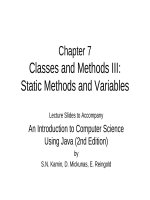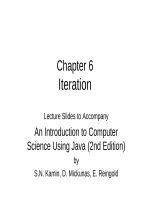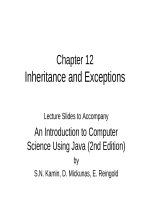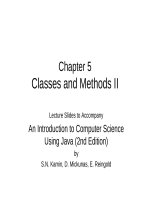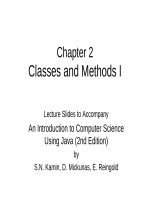Lecture An introduction to collective bargaining and industrial relations (4e) – Chapter 4: The role of the environment
Bạn đang xem bản rút gọn của tài liệu. Xem và tải ngay bản đầy đủ của tài liệu tại đây (569.05 KB, 31 trang )
Chapter
4
The Role of the
Environment
McGrawHill/Irwin
An Introduction to Collective Bargaining & Industrial Relations, 4e
Copyright © 2008 The McGrawHill Companies, Inc. All rights reserved.
1 3
A Conceptual Framework to Analyze the
Environment
• John Dunlop, the former U.S. Secretary of Labor,
classified the industrial relations environment into
three main influences:
1. The economic context
2. The technological context
3. The locus of power in larger society
4 3
1 4
4 4
Bargaining Power
• The ability of one party to achieve its goals in
bargaining in the presence of opposition by another
party to the process
• Union power is influenced by the ability to
withdraw services through a strike
• Employer’s bargaining power is influenced by
the ability to withstand a strike
• “Working to rule” may be attempted by the
union
1 5
How Strike Leverage Influences Relative
Bargaining Power
4 5
• “Strike leverage” is the relative degree to which
workers and the employer are willing and able to
sustain a strike
• To measure leverage, we need to know what costs a
strike would impose on each party
• Also, what alternative income sources are available to
each party to offset any income losses induced by the
strike
1 6
4 6
The Economic Context
• Microeconomic Influences on Bargaining Power
Management’s Strike Leverage
• The more an employer is willing and able to
sustain a strike, the more likely the work force
will be to settle a strike before attaining all the
union’s goals
• Determinants of management’s strike leverage
are:
• 1) Essentiality of striking workers on production
• 2) Availability of inventories for sales
• 3) Effects on profits
1 7
4 7
The Union’s Strike Leverage
• Determined by the ability and willingness of the work
force to stay on strike
• The longer workers are willing and able to stay on
strike, the greater the bargaining power of the union
and the likelihood of a favorable outcome for the
union
Alternative sources of income, strike benefits, and
solidarity influence strike duration
1 8
4 8
The WageEmployment Tradeoff
Strike leverage determines whether workers are able to
press for higher wages
Higher wages often bring cuts in employment
In some cases, unions opt not to raise wages as
much as they could
Thus, the “wageemployment tradeoff”
1 9
4 9
Marshall’s Four Basic Conditions
• Marshall’s Four Basic Conditions
Marshall argued that unions are most powerful
when demand for labor is inelastic (i.e., when
large wage increases do not cause layoffs)
Such conditions are:
• When labor cannot be easily replaced in the production
process by other workers or machines
• When demand for the final product is price inelastic
• When the supply of nonlabor factors of production is
price inelastic
• When the ratio of labor cost to total cost is small
1 10
Examples of Union Efforts to
Influence Consumer Demand
4 10
1 11
Macroeconomic influences on Total and
Relative Bargaining Power
4 11
• Economists refer to unemployment and the growth in
national product or productivity as macroeconomic
factors
• The higher the unemployment rate, workers are less
likely to support a strike
• During the growth phase of the business cycle, job
availability increases and union strike leverage is
enhanced
1 12
4 12
The Effects of Collective Bargaining on
Macroeconomic Performance
• Do Unions Cause Inflation?
For union wage increases to lead directly to inflation,
the unionnonunion wage differential would have to be
ever widening
Although the differential widened during the 1970s, it
narrowed during the 1980s and 1990s
Thus, the earnings differential does not apparently
produce inflation
Furthermore, unions represent a small percentage of
the workforce
1 13
4 13
The Political Influence of Unions on the
Macro Economy
• Some observers believe union political lobbying has a
greater influence on the wageprice spiral than the
direct effects of union wages
• Expansionary government policies allow the re
employment of workers displaced by inflationary
wage increases
• Unions also support a wide range of economic and
social policies that supplement its collective
bargaining efforts
1 14
4 14
The Legal and Public Policy Context
• The Legality of Unionism and Union Activity
Public policy determines how easily unions may
form and sustain themselves
Banning unions is one extreme, while requiring
union membership is the other extreme
States and the federal government perhaps have
taken a middle course
1 15
The NLRA’s Effects on Bargaining
Power
4 15
• The NLRA grants unions the right to strike and
obligates employers to bargain in good faith
• Without these rights, the bargaining power of unions
would be weakened
• TaftHartley amendments made it illegal for
supervisors to join unions representing production
workers
1 16
4 16
An Illustration of Government
Employment Regulation: Pensions
The Employee Retirement Income Security Act
(ERISA) of 1974 had a profound impact on pensions
• It specified minimum standards for vesting of
contributions
• Required more detailed reporting and disclosure
• Requires future liabilities to be funded on an annual
basis and past liabilities to be amortized
• Established insurance protection through the
Pension Benefit Guaranty Corporation (PBGC)
1 17
The Shift to Less Government
Intervention
4 17
• From the late 1970s, U.S. public policy changed to a
less interventionist style, with an emphasis on
competitive markets
Deregulation and privatization were emphasized
• The increasing internationalization of the economy
has raised questions about the relevance of the 1930’s
labor laws
1 18
4 18
Labor Force Trends
• The labor force grew rapidly following WWII, as a
result of the babyboom
• Growth slowed in the late 1970s
• The median age of the labor force peaked in 1960
at 40.5 and declined to 34.8 by 1982
• By 2008, one of six workers will be over the age of 55
These patterns mean that unions and employers will be
faced with an aging work force and rising pension costs
1 19
4 19
Women in the Labor Force
The growing number of women in the labor force is
one of the most significant labor force developments
In 1972, onehalf of all women participated in the
labor force
In 2005, 72.6 percent of women between the ages of
25 and 54 worked
The employmentpopulation ratio for adult women
reached a record high of 60.3 percent in 2000
The general trend can largely be explained by
women’s changing marital status, education, and
career expectations
1 20
4 20
Educational Attainment
• Educational levels of the work force have increased
In 1990, the median years of school completed for
all workers was 13
In 1970, 63.9 percent of all workers had graduated
from high school and 12.9 percent from college
By 2005, only 9.6 percent of the civilian work
force had less than a high school diploma while
32.8 percent were college graduates
1 21
4 21
Occupational and Industry Trends
• The white collar sector has grown since 1960
From 43 percent to over half now
• Service sector employment was 83.4 percent in
2004, with goodsproducing jobs 16.6 percent
• As recently as 1950, goodsproducing jobs were
40.9 percent
These changes have had a profound impact on
collective bargaining and unionization
1 22
4 22
Is the U.S. Economy Deindustrializing?
Some contend that the decline in manufacturing jobs
may have led to greater income inequality
Others feel that service sector and parttime work is a
response to availability and desire of the workforce
They note the large growth in the workforce compared
to Europe
Organizing parttime and some service workers is
more difficult for unions, as they may be more easily
replaced and have less leverage
1 23
Demographic Profile of Union
Members
4 23
The average union member is more likely to be
working in industries, occupations, and regions in
which demand for labor is either declining or growing
at a slow pace
Women are underrepresented in the unionized sector
The traditional constituency of unions – male, blue
collar workers living in the northeast or north central
regions – is declining
1 24
4 24
Demographic Challenges for Unions
• Demographic diversity can affect union policies
• The more heterogeneous a union, the greater the
potential for internal conflict and the union will have
greater difficulty establishing bargaining priorities
• If unions succeed in organizing new workers, they
will face pressures for change
1 25
4 25
The Social Context
• Polls reveal fluctuations over time in the public’s
image of unions
• The percentage of the public that approves of labor
unions, according to the Gallup Poll, fell from 71
percent in 1965 to 55 percent in 1981
• Public approval rose to 65 percent in 1999, but fell
again to 58% in 2005
• More of the public was sympathetic to unions in labor
disputes (52%) than to companies (34%)
